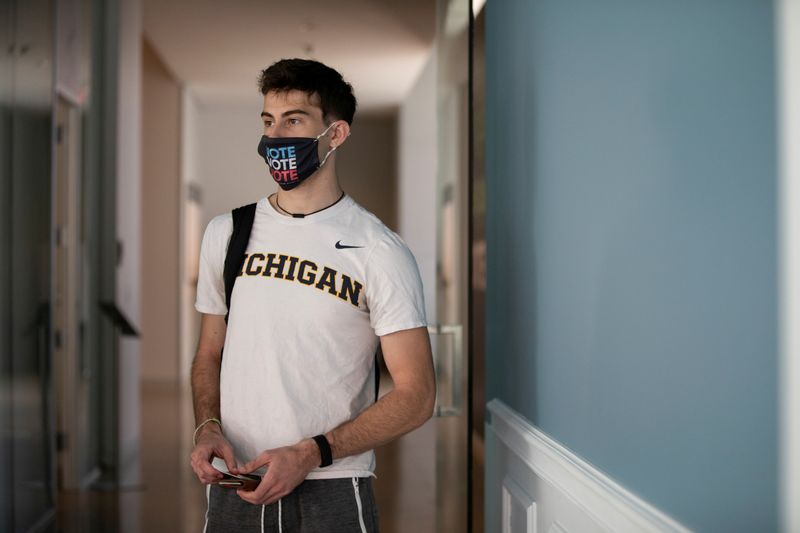WASHINGTON (Reuters) – The summertime push to shed masks and rush back to normal life, particularly intense in U.S. electoral battlegrounds like Wisconsin and Michigan, has ended where many experts at the time predicted it would: With a still rapidly spreading virus and a muted economic recovery.
With the daily growth in cases spiking across many Republican-leaning areas and rising nationally, high frequency economic data has shown the economic recovery potentially stalling across states critical to President Donald Trump’s chances in a presidential vote two and a half weeks from now.
That includes the “Rust Belt” states that sparked his victory in 2016 as well as the western plains states considered a firm part of his base – all of them places where his supporters were wary of masks and other measures to mount a unified national response to the pandemic.
For Trump, trailing in most polls to Democratic challenger Joe Biden and dragged down by his response to the pandemic, the initial instinct was to avoid national health restrictions in favor of a faster economic reopening.
That gambit has not paid off.
An Oxford http://blog.oxfordeconomics.com/topic/recovery-tracker Economics state-level recovery tracker now shows economic progress has slowed or fallen in seven electoral swing states, “and with the virus now surging again in the Midwest, that likely means conditions will weaken in the run-up to the election,” said Oxford analyst Oren Klachkin.
Graphic: Fast summer, slowing fall in swing states https://graphics.reuters.com/USA-ECONOMY/REOPEN/gjnvwlykgpw/chart.png
Analysis by Homebase https://joinhomebase.com/data, which manages employee time for small firms like restaurants, showed many states registered a drop since mid-July in the number of businesses open, with the declines sharpest in states like Wyoming and South Dakota where the virus is growing fastest now, and more moderate in the swing states of Wisconsin, Michigan, Ohio and Pennsylvania.
Graphic: Small business openings since mid-July https://graphics.reuters.com/USA-ECONOMY/REOPEN/rlgpdxkgopo/chart.png
National retail foot traffic data from Safegraph https://www.safegraph.com/dashboard/covid19-commerce-patterns and Unacast https://www.unacast.com/covid19/covid-19-retail-impact-scoreboard all declined last week. A Unacast recovery tracker showed a nation potentially slipping into reverse. At its peak over the summer more than half of states had seen traffic to retail locations push back above 2019 levels; as of last week the number was down to four – Mississippi, South Dakota, Wyoming and Montana.
Graphic: Retail in real time https://graphics.reuters.com/USA-ECONOMY/REOPEN/xegvbjdrnvq/chart.png
Across a broad set of industries whose employee time is managed by UKG https://www.kronos.com/about-us/newsroom/update-us-workforce-activity, “workforce activity has fizzled,” said UKG vice president of strategy and operations Dave Gilbertson, with growth in the number of shifts worked falling steadily since Labor Day, and now declining for firms with fewer than 100 people.
Graphic: Jobs in real time https://graphics.reuters.com/USA-ECONOMY/REOPENING/azgvoaggdvd/chart.png
“Businesses appear to be reaching the inflection point of labor recovery,” he said, reflecting “concerns around consumer activity in the upcoming holiday season and long-term economic stability in the face of a stalling jobs recovery and a second upswing of COVID-19 cases across pockets of the U.S.”
An index of labor demand calculated by Chmura http://www.chmuraecon.com/blog has remained steady through the fall, with new job postings at roughly 80% of their predicted level without the pandemic.
LOOKING MORE LIKE A ‘K’
Federal Reserve and other officials have grown increasingly concerned about the durability of the U.S. economic rebound.
Overall measures of economic output have remained sturdier than expected in March, when the pandemic took hold and triggered the deepest economic slump in the post-World War Two era.
While the U.S. economy remains technically in recession, growth from July through September has been strong, and by year’s end some feel the size of the U.S. economy may be within perhaps 2.5 percentage points of where it was at the end of 2019 – a remarkable outcome in the context of the collapse registered in March and April.
A New York Fed index relying on higher frequency weekly data has shown steady improvement in expected gross domestic product, the most general measure of economic output.
Graphic: NY Fed Weekly Economic Index https://graphics.reuters.com/USA-ECONOMY/WEI/azgpoagodpd/chart.png
An Oxford national recovery tracker using health, social and economic data rose over the past week.
Graphic: Oxford Economics Recovery Index https://graphics.reuters.com/USA-ECONOMY/OXFORDINDEX/yzdvxqzmkpx/chart.png
But the Oxford index has also remained bound at about 80% of where it was before the pandemic, showing the limits of the recovery absent some turn in the health crisis.
There’s is also concern the economy may sputter further if the virus surges into the fall, with millions already unemployed and large sets of companies, especially in the vulnerable services sector, still waiting for customers to return.
Even with an uptick last week restaurant seatings tabulated by OpenTable https://www.opentable.com/state-of-industry remain less than 70% of their March 1 level.
More broadly, the job market has been adrift. The unemployment rate has been falling faster than expected, but in part because millions have given up the search for work altogether. Each week, hundreds of thousands file to join the unemployment line, with the number rising 53,000 to 898,000 for the week ending Oct. 10.
It’s a situation that undercuts the populist argument Trump used in 2016. Equity markets and the economy in general keep moving forward, but many workers are left on the sidelines and others tied to industries that are not recovering – a disconnect between macroeconomic outcomes and what’s being felt across households.
“We are seeing manifestations of a ‘K’ shaped recovery under a macro ‘U’,” of steady growth from the low point in the spring, said Nathan Sheets, a former Fed official and chief economist at PGIM Fixed Income. “Upper-income households have been doing quite well, lower income more severely” affected by the pandemic.
(Reporting by Howard Schneider; Editing by Andrea Ricci)






















